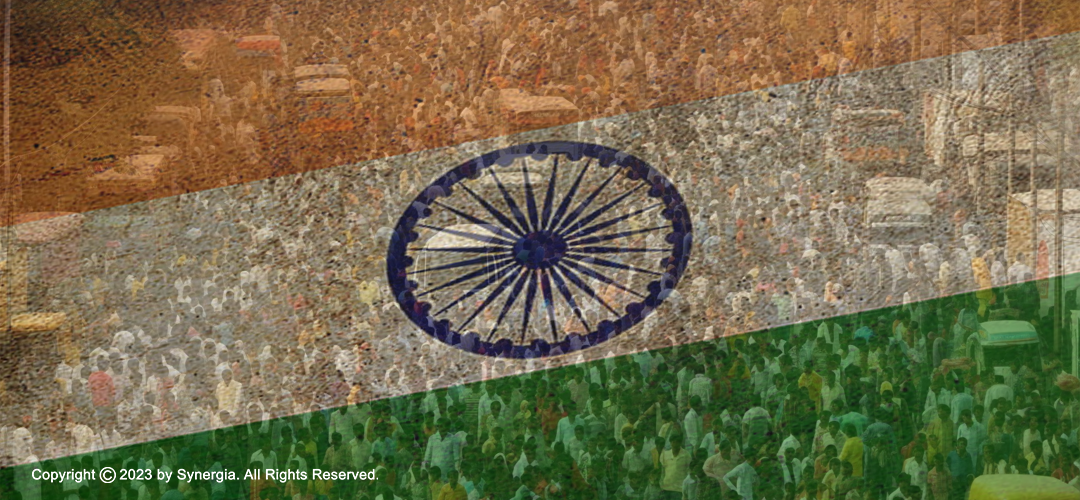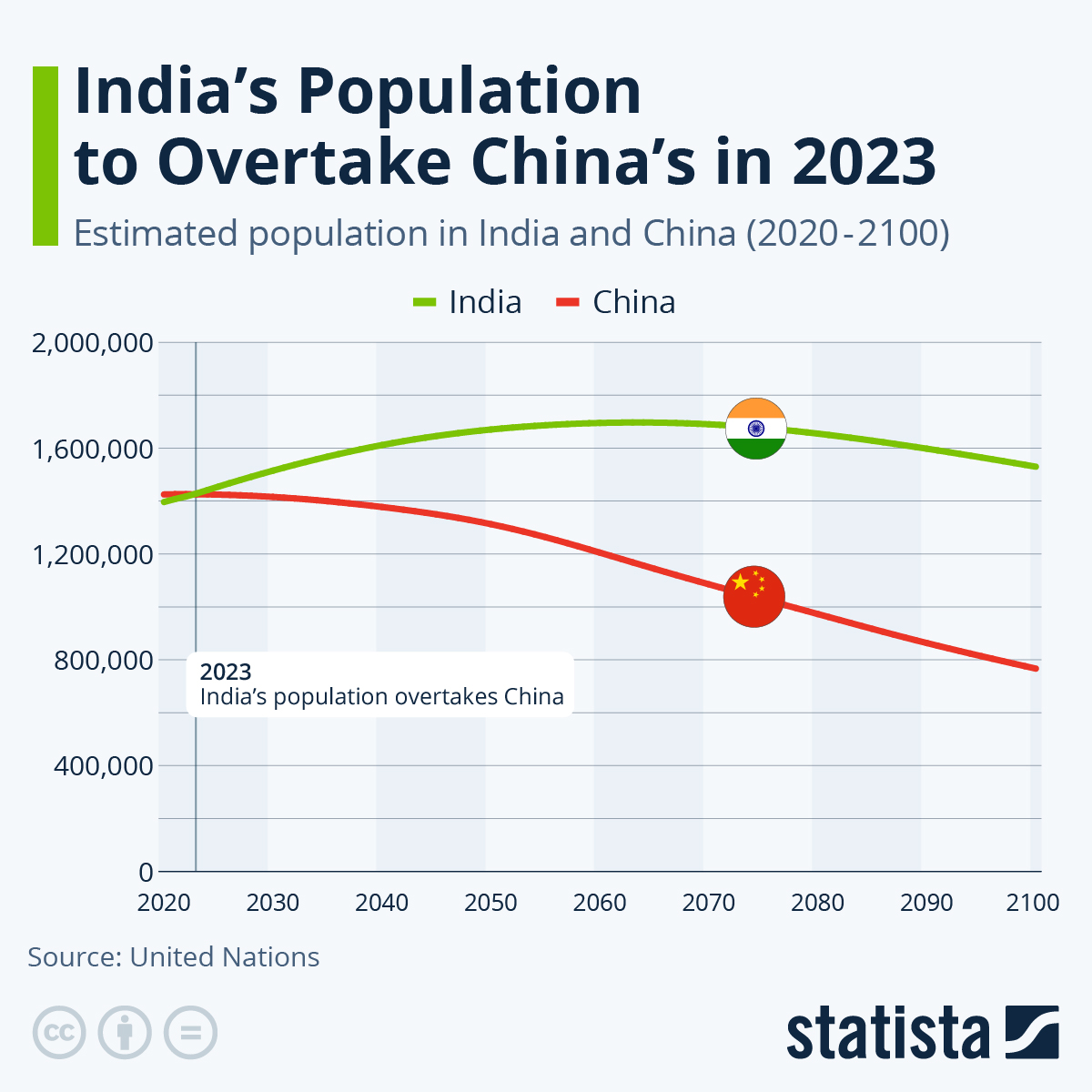Leading the Pack!
June 17, 2023 | Expert Insights

Last month India took on the dubious title of the "world's most populous nation," outstripping the People's Republic of China. This was not a surprising development as, over the last few decades, China has managed its population control policies with such determination and ruthlessness that there has been a steep decline in its population growth. Therefore, with the Indian population maintaining a healthy growth rate, it was a matter of time before we overtook our larger neighbour and the second-largest global economy.
Can India replicate the Chinese population control success and, in the interim, manage its youthful population dividend to grow economically? This question remains uppermost in the minds of those entrusted with charting the course for India for the future.
Background
The UN estimates for China's population don't include its two Special Administrative Regions - Hong Kong and Macau, as well as Taiwan, an island with its constitution and democratically elected leaders, that Beijing sees as a breakaway province to be unified with the mainland.
The country implemented stringent policies in the 1970s and 1980s to slow and reduce population growth. These policies were extremely successful at first, resulting in swift changes in population. However, the sharp decline in population growth rates comes with its own baggage as, like most developed economies, China, too, faces a growing segment of ageing and non-productive population with a corresponding decline in the productive younger profile manpower.
Today, China’s fertility rate is among the world’s lowest at 1.2 births per woman and is expected to continue to fall by 10 per cent over the next two decades.
India postponed its 2021 census to 2024, so figures provided by the UN are simply estimates and projections due to the lack of official data. India is believed to have overtaken China as the world’s most populous country this year. With a fertility rate of 2 births per woman, just below the replacement threshold of 2.1 per cent, the rate required for population stabilisation in the long run, India's population is expected to peak in 2064, then decline gradually.
Population growth was not uniform throughout the country, as under the Indian federal structure, states had the power to set their own policy priorities. The states of Bihar and Uttar Pradesh will contribute to 1/3rd of the projected growth, whereas southern states have already achieved population rate stability, and growth rates have begun to fall. Some, such as Kerala and Tamil Nadu, are expected to be dealing with ageing populations by 2025.

Analysis
Social compulsions in China have also played a pivotal role in causing an unbalanced gender makeup; a traditional preference for male children has resulted in female foetuses being aborted or abandoned/ killed soon after birth. This means men struggle to find partners the same age, and fewer women are willing and capable of birthing children. Shifting priorities, increased education of women, rising costs of living and trends of marrying later have also impacted this population decline.
The window of opportunity created by a changing demographic - that resulted in a large proportion of the population being of working age - is closing, as the population has reached its peak and is becoming an ageing demographic, with the elderly making up a fifth of its population. This means China can no longer depend on its labour-intensive, export-led growth model.
The Chinese economy must increase the rate of productivity growth or quickly reverse the population trends to be able to sustain the economy's heady pace of expansion. As the population ages, the country will experience a loss of human capital. The impact of this will be felt more in some industries than others - manufacturing and construction industries bearing the brunt.
This labour shortage will also mean increased labour costs, which could make Chinese companies less competitive in the global marketplace. However, a significant labour shortage is not expected in the short term, as China already has a large workforce.
China may resort to adopting more coercive tactics to encourage citizens to reproduce, as their current measures and policy changes to encourage population growth have been largely unsuccessful. Immigration levels are currently low, but this may also change if the country takes measures aiming to increase its labour force.
As their population continues to age, the nation will experience growing pressure on its shrinking workforce and social security system as demand for these services grows and aggregate demand falls. A declining population may result in decreased customers and an increased proportion of the elderly- who are less inclined to spend than younger citizens. This might impact the market size. On the other hand, healthcare, pharmaceuticals, services for the elderly and other related goods are industries that will see growing demand in coming years - the value of China's eldercare market is estimated to reach US $3 trillion by 2030.
It must be kept in mind, however, that these issues impacting labour markets and inflation will also make it more difficult for China to reach its goal of overtaking the U.S. as the world's largest economy if they are unable to adapt to these demographic changes.
The average age in India currently is 29, and the population is expected to remain that of a young demographic for the next two decades. This population bulge will provide India with the benefits of a demographic dividend for economic development, as the population has a greater proportion of people of working age.
However, India struggles with youth unemployment; only 50 per cent of the current workforce is employed, and only 5 per cent is formally skilled. Only 20 per cent of women of working age are participants in the formal labour market, and this number continues to fall as India develops. To make the most of the demographic dividend, efforts must be made to encourage and incentivise employment, improve education and create more employment opportunities.
Steps have been taken to achieve this, such as the Prime Minister's flagship scheme, "Make in India", which aims to increase the growth of the secondary sector and pushes to increase manufacturing exports and growth. Meanwhile, the "Skill India" initiative focuses on improving the education and skill sets of the youth through training and skill-development partnerships, even partnering with various international companies. This will better equip workers with the skills companies require and improve employment rates.
Additionally, India is still grappling with the prevention of child marriages and the need to properly register births and deaths. It also sees a growing requirement to create more employment opportunities, improve education and healthcare systems to keep up with its growing workforce and ensure productive and sustainable development.
Furthermore, varied growth rates throughout the country mean that southern states will face ageing populations by 2025, which will become a growing burden on the government's resources. Issues stemming from an ageing population may, however, be alleviated by the migration of workers between states and districts of India. Contrarily, the migration of workers is usually to cities in search of work, but if these cities are unable to support their growing population size, they will face rising levels of poverty and falling living standards.
In addition to inequalities in population growth rates, India faces a great challenge from growing wealth inequality, with the top 10 per cent of the population holding more than 60 per cent of the country's wealth and the lower 50 per cent holding only 6 per cent of the wealth. This widening gap poses a threat to the nation's economic growth.
The unequal population growth in the North and the South has implications for the political landscape in India. This lack of uniformity may cause electoral lines to be redrawn and revised in 2026 based on census data regarding the number of people in constituencies. Potentially, it can change the number of parliamentary seats that each state will get, and as per existing norms, the seats will increase for states showing larger population growth. Theoretically, a revision of electoral rolls based on the next census could impact the political representation of India’s southern states in the parliament.
India's abundant supply of labour is expected to attract more foreign investors looking to profit off India's growing manufacturing abilities. Rising domestic consumption created by the growing, young population will also hasten and encourage economic growth. India has become one of the world's fastest-growing economies and is expected to overtake Germany and Japan to become the world's third-largest economy by 2030.
India having the world's largest population, could also strengthen its claims for permanent membership in the UN Security Council. India has bid for this position extensively over the last few years and received backing from 4 of the 5 permanent members, unfortunately being vetoed by China.
As the most populous country in the world, it certainly deserves a seat at the top decision-maker's table.
Assessment
- China can no longer depend on its labour-intensive, export-led growth model. Its manufacturing will have to upgrade to automation and AI to keep it competitive. The Chinese economy must increase the rate of productivity growth or quickly reverse the population trends to be able to sustain the economy's heady pace of expansion. It must make efforts to increase domestic demand and improve its eldercare and healthcare sectors in view of the growing population of elderly.
- To make the most of the demographic dividend, India must make efforts to encourage and incentivise employment, improve education and create more employment opportunities to keep up with its growing workforce and ensure productive and sustainable development. The nation must also remain wary of the growing wealth gap.








Comments